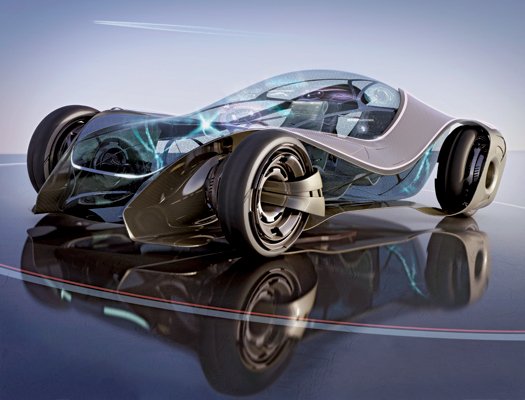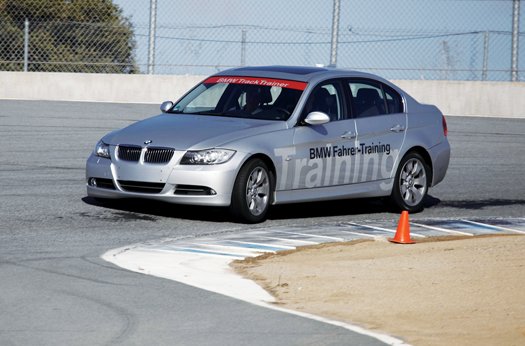Extremely Mobile Devices

Silicon Valley Smart Car Some cars already require more code to run than a commercial jet, and they will increasingly use that brainpower to take control of braking, steering and acceleration. By 2030, one engineer predicts, we’ll be summoning driverless cars by cellphone to come pick us up at the airport. Nick Kaloterakis
“You can grip the wheel very loosely,” the BMW engineer told me as I settled into the driver’s seat of the BMW Track Trainer. “Very loosely, to get a feel for how it is turning. But do not touch the pedals.” I detected in his tone an “unless” on the way. “Unless I yell stop! In which case you should grip the wheel tightly and stomp on the brakes.” He smiled. “Shall we go?”
With that, I released the brake and sat back as our unassuming 3 Series sedan accelerated of its own volition down a short straightaway, whipped ably into a right-hander, and then moved wide to set itself up for a fast curve to the left. I was, as instructed, holding on ever-so-slightly, but that felt weirder than just watching the wheel turn on its own, as if I were sitting in the lap of a ghost driver—which is pretty much what I was doing.
The BMW Track Trainer is a robot car: a fully autonomous automobile capable of racing the Mazda Raceway Laguna Seca in California’s Monterey County (or any other track it’s been programmed to run) at the limit of traction, mere seconds off the time a professional would run in the same model. BMW uses it to train drivers by showing them how the perfect racing line feels from the driver’s seat and by providing real-time feedback, with corrections, once they decide to take over the controls themselves. But the car is also a showcase for BMW’s Driver Assistance System, a series of radar and GPS sensors that work in concert with computer-operated steering, brake and power systems to achieve what BMW describes as “highly autonomous driving.”
Robo-Coach: BMW uses its Track Trainer, a self-driving sedan, to teach racers how to make optimal turns and engineers how to make optimal drive systems. Courtesy BMW
BMW chose Laguna Seca because it is a difficult track, which makes barreling into turns at 100 mph all the more impressive, and because it’s a short drive from the company’s research lab in Silicon Valley, where engineers are busy reinventing the automobile for the information age. Since 1978, when microprocessors were first installed in the trip odometer of a Cadillac Seville, the number of chips in the average automobile has grown such that cars now contain anywhere from 50 to 200 processors and a mile of wiring. The increasing prevalence of hybrid and electric cars is accelerating that trend; the plug-in electric Chevrolet Volt, for example, requires 10 million lines of code, two million more than it takes to run a Boeing 787.
So carmakers are coming to Silicon Valley, where code is king. Mercedes-Benz opened a technology center here in 1995, BMW in 1998, Volkswagen in 1998, Toyota in 2001, General Motors in 2007, and Renault-Nissan in the past year—all in large part to tap the skills of the designers and developers and engineers and who have so ably sustained Google, Apple and Facebook. Include homegrown start-ups Tesla Motors, Mission Motors and the autonomous car division at Google itself, and the result is a sort of Detroit West, where California engineers continue to devise new ways to make powerful, affordable, easy-to-use computers—but now they also devise new ways to make them move very, very fast.
Exactly how I felt about all this is something I was chewing on when the Track Trainer crested the hill that leads into Laguna Seca’s infamous “corkscrew.” I had to trust that this robot racecar would remember how to negotiate one of the trickiest and most dangerous corners in the world, a hard left followed immediately by a hard right on a stretch of track that drops five and a half stories in 450 feet. Cresting the hill, the car managed not to panic and brake too soon, as humans tend to do. In fact, as we plunged into the turn, I thought for one terrifying moment that the car wasn’t going to brake at all—until it did, with perfect timing. As we safely exited, I realized I’d just hitched a brief ride into the future.




Click here to get an inside look at Silicon Valley’s automotive innovations.
Silicon Valley is a surprisingly big place. Getting around requires a lot of driving, which on California’s well-maintained roads is pleasant enough even without robot assistance. And as I drove my rental car from lab to lab, interesting relationships began to reveal themselves.
The engineers at the Volkswagen Electronics Research Laboratory (ERL), for instance, work in a white midrise office building just across a narrow marshy river from the headquarters of Oracle, the company best known for its database-management program. Managing data seemed to be about a different from what automakers do as any pursuit could be. But when ERL’s deputy director, an electrical engineer named Chuhee Lee, met me at the lab, he made it clear that this was not at all the case.
In a second-floor conference room, Lee launched a PowerPoint presentation that he had used many times to justify his lab’s existence to managers back in Munich. Combining data, it turned out, is the essence of new car design. Car engineers had long thought of the various data devices they installed—navigation systems, smartphone adapters, lane-detecting cameras—as independent gadgets with narrowly tailored functions. Now they’re beginning to link these devices to one another, to connect the data from a car’s many sensors and processors. And like the engineers at Oracle, they’ve found great value in these connections.
Posted on September 15, 2011, in automobiles and tagged devices, Extremely, Mobile. Bookmark the permalink. Leave a comment.
Leave a comment
Comments 0